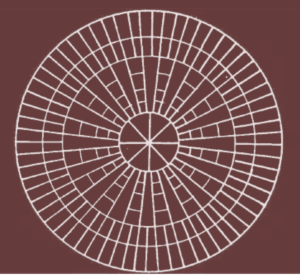Katyayana and Sulba Sutra
Kalpa Sutra literature clarifies the steps related to Yajna rituals. They are highly specialized in nature. Sulba Sutra texts belong to this category. These texts explain the geometry steps in constructing a Vedi or a fire altar and the temporary structures around it. Experts in rituals wrote them, four to five millennia ago. However, the works of only four have survived. Katyayana’s work on Sulba Sutra is the shortest and the simplest among them.
The Asiatic society of India hired European scholars to translate the Vedas. These scholars in turn took the generous help of native subject matter experts in the Vedas. Despite this help, early European scholars found some texts challenging. Therefore, they had to train junior scholars who were smarter. Besides, a translator could not apply guess work of any sort with a text like the Kalpa Sutras. Let us understand the reasons by looking at Katyayana’s work.
Katyayana’s text has only six short chapters. These chapters contain a total of 67 short rules or statements. These rules are instructions to construct a Vedi fire altar from specially made bricks. A Vedi can have a few common shapes such as circular, triangle and square. Some Vedi can have fancy shapes such as tortoise, chariot and bird. Besides, the bricks are laid following a certain constraint. This is like solving a jigsaw puzzle, but one chunk or an area at a time. However, the chunks must move from a center to the edges. Secondly, the chunks must be the same size . Thirdly, a chunk can only be a square, nectangle, rhombus, trapezoid, or triangle.

Katyayana and Astronomy
Katyayana’s Sulba Sutra text begins with a method to locate the cardinal directions, East, West, North and South. Astronomers today know this as the Indian circle method. Most ancient astronomy treatises from India, such as the Surya Siddhanta, refer to his technique. This is a simple and robust way to locate the cardinal directions without a magnet. Those who know Sanskrit can appreciate how well Katyayana conveys this technique, using a minimum number of words.
1.1 rajjusamāsam vaksyāmaḥ
1.2 same šankum nikhāya saňkusammitayā rajjvā mandalam parilikhya yatra lekhayoḥ sankvagracchāyā nipatati tatra sankū nihanti să práci /
tadantaram rajjvābhyasya pāśau krtvā sankvoḥ pāśau pratimucya dakșiņāyamya madhye śankumevamuttarataḥ sodīci/
India has millions of scientists and engineers today. There were probably none when these ancient texts were translated. Anyone with some knowledge of geometry can appreciate the beauty in Katyayana’s work. Unfortunately, many do not know about these texts and their translations.